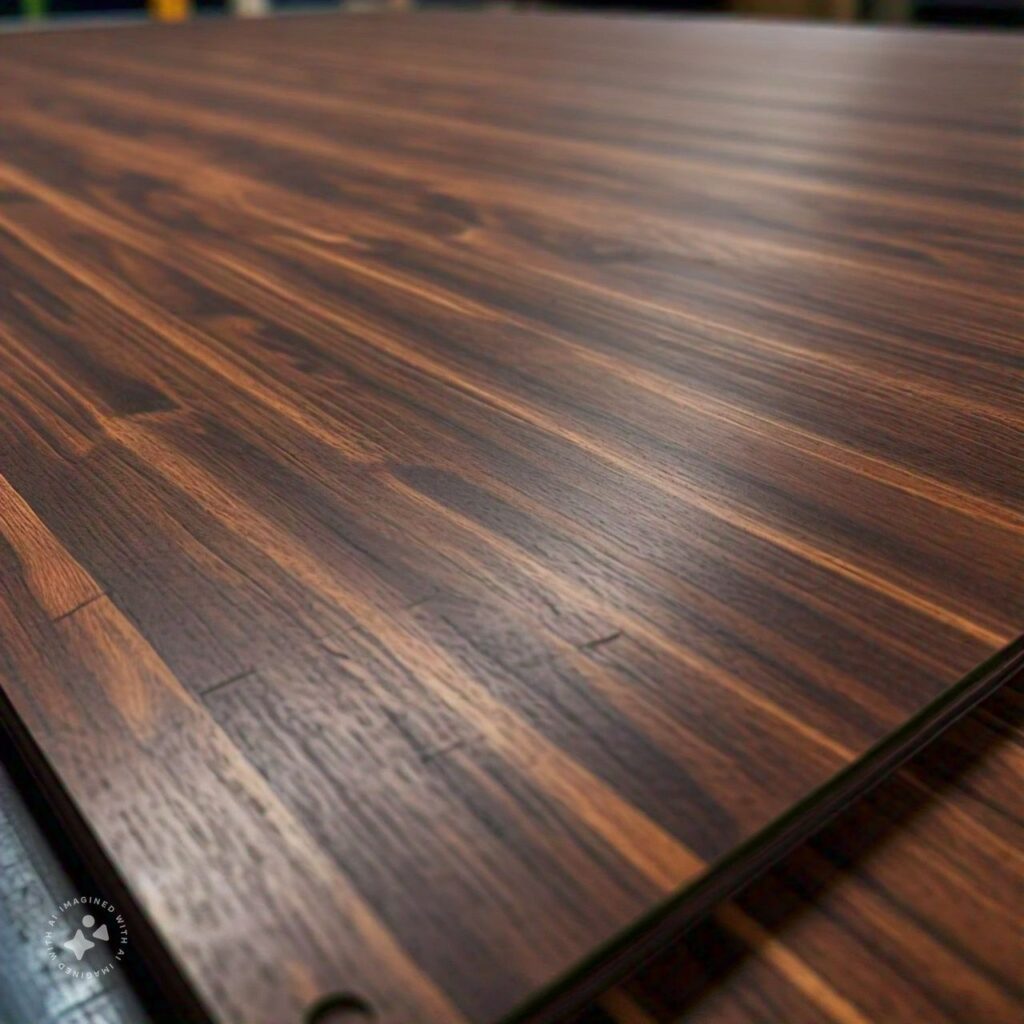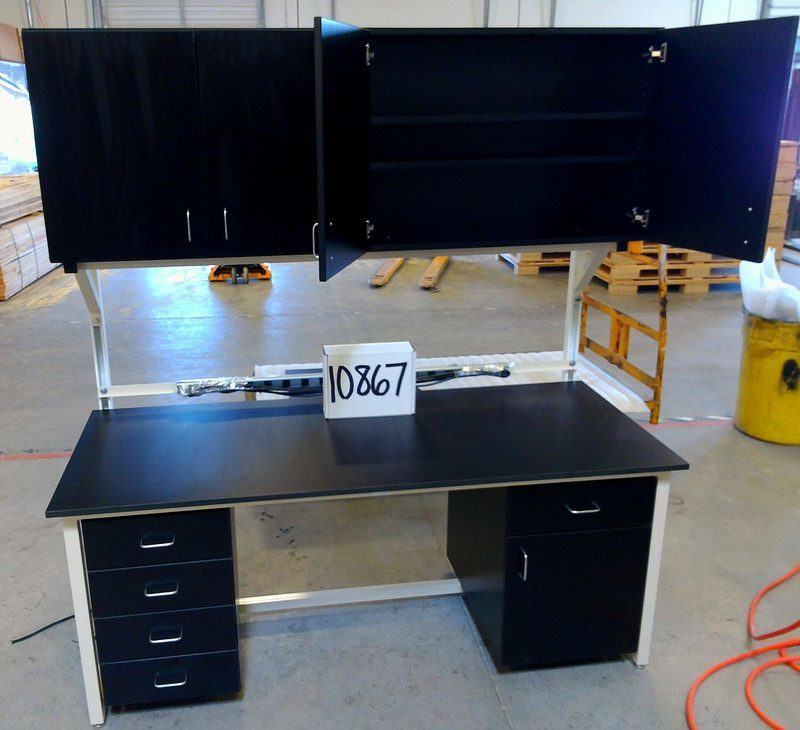Phenolic plywood is somewhat of a misnomer. It should more realistically be called “phenolic-faced plywood,” “phenolic-faced plywood,” or “phenolic-covered plywood.” The veneer core plywood isn’t made of phenolic resin but is generally birch plywood. It is “phenolic” because both surface veneers are soaked in phenolic resin before attaching them to the plywood. This creates an extremely stable, smooth, durable, highly water-resistant, and attractive surface.
These face veneers can be wood (normally birch) or thick paper, like the core veneers. In either case, they are limited to the core plays under pressure, creating a permanent bond. The actual material doesn’t matter so much as it is merely the carrier for the phenolic rosin. A thick layer of this is unnecessary, as it is a coating. If a thicker layer of the phenolic film were to be thick paper was used, there would be no additional advantage.
Some people refer to plywood’s phenolic coating as “resin-impregnated plywood,” although this is inaccurate. The other layers are regular hardwood veneers.
Many are made with thin veneer layers, whether high-grade or marine-grade hardwood plywood. Depending on the manufacturer, a 3/4″ sheet of phenolic plywood will likely have either 13 or 15 layers.
Combining thin, consistent veneers and being void-free provides an attractive edge when machined for industrial-look furniture or store fixtures. Like most cabinet-grade plywood, it is void-free.
What is Phenolic?
Phenolic, created in 1907, was the first synthetic plastic resin and the material used to create Bakelite. Before other plastics existed, electric light switches and other electronic devices were molded from Bakelite.
It is a thermosetting plastic, meaning that it sets into shape by a chemical reaction that produces heat. This allowed Bakelite to be molded in low-pressure molds. In contrast, most of today’s plastics are thermoforming, melting, and forming by heat. This requires expensive injection molding machines and molds that withstand high pressure and temperature.
This difference explains how phenolic can coat an engineered wood product while more used chemicals and modern plastics cannot. Since it is molded to the plywood veneer as a liquid, it can soak into the wood fibers, bonding entirely with them.
To attempt to do that with chemicals or a thermoforming plastic would require an adhesive that could bond to both the plastic and the wood fibers (those are hard to find), unlike phenolic, which acts as its adhesive.
Phenolic plywood is primarily manufactured in Scandinavian countries, primarily from Scandinavian Birch. While it is used more extensively in European countries, it is slowly gaining in popularity in the US, primarily for store and shop fixtures, where the smooth surface is a distinct advantage. It is somewhat more expensive than other types of plywood, roughly the same price as marine grade plywood, which is manufactured to similar specifications.
Since it is a primarily European product, don’t be surprised to find it in metric sizes or five-foot square sheets. However, most companies provide it in standard four-foot by eight-foot sheets for use here in the USA. Some companies offer 24″ x 48″ project panels, which are, at least, more accessible to ship. Another option is custom cut sheets, which are available online.
Phenolic surfaces
The phenolic-covered plywood surface provides several characteristics not found in other plywood products. Amongst the attributes of the various types and multiple plywood colors available, phenolic provides the most challenging and stable surface.
The phenolic surface is highly resistant to cracking and splitting from fasteners. It is also exceptionally smooth and frictionless, making it ideal for slipping other wood pieces over.
Phenolic plywood is available in various colors, although most lumberyards only carry one or two colors (black and dark brown are the most common). Nevertheless, the other colors can be ordered, especially if a large quantity of dark brown plywood is needed.
Painting phenolic film on plywood is not recommended, as most paints do not bond well with the film’s surface. Painting the film requires special paints, and even then, there is a chance that the paint will peel off the slick surface.
While the phenolic resin provides a high degree of water-repellency properties, this is not the same as saying that phenolic-coated plywood is waterproof. Unlike MDO (Medium-Density Overlay) and HDO (High-Density Overlay), the resin is only on the two faces; it is not used as an adhesive for the veneer layers in the core of the coated plywood. Therefore, the coated plywood can still absorb water through the edges of the panel.

Proper finishing of the panel edges can increase the water repellency and high moisture resistance of the phenolic plywood panel, increasing the shelf life and the utility of this product in wet environments, such as commercial bathrooms (for partitions) and laundry rooms.
Phenolic panels are often used to make furniture in these wet environments when a wood or plywood panel is desired, but high water and moisture resistance is also needed.
This water repellency also makes it challenging to use phenolic plywood with adhesives. For adhesives to work, they need to be able to get a “bite” on the surface. The smooth surface resists adhesives exceptionally well. Therefore, it is recommended that anything built with phenolic plywood be assembled with fasteners rather than adhesives. The only place where the adhesive would be effective is on the panel edges, as an additional support for the fasteners.
Use of Phenolic plywood
The most durable and common use of phenolic plywood is in constructing and making the workshop’s jigs, fixtures, and cabinetry. The low friction coefficient provided by the thickness of the phenolic material makes it very durable and extremely easy to slide work pieces across it when used as a tool table or fence.

Phenolic plywood is gaining popularity in specialized cabinetmaking applications. Although it does not provide the same finishing options as regular cabinet grade or hardwood plywood, it does offer a smooth, clean, water-repellent surface with consistent color. If you can find a good source, the specialized phenolic plywood is available in various colors. This gives rise to specialized phenolic plywood for cabinetry in laundry rooms, garages, and other work areas of homes, workshops, and businesses.
For furniture or store fixtures, phenolic plywood can provide a rustic “warehouse” look popular in many casual clothing stores and some restaurants while being extremely practical, durable, and attractive. The natural coloration of the panels eliminates the need for painting, while the stability and ruggedness ensure that the fixtures will keep their good looks without becoming easily dented, scratched, or chipped.
Another growing use of the phenolic coating on plywood is in building furniture and laboratory fixtures. The phenolic coating’s water—and chemical-resistant properties make this a superior material with high moisture resistance while providing an attractive and durable finished product. Depending on the specific application and aesthetics desired, the edges can be finished, covered with an edge band, or covered with an edge board.
The rugged appearance and durability of phenolic plywood make it a popular choice for many other furniture applications anywhere durability is a prime consideration. School lockers, sports furniture, and furniture for science laboratories are all made of phenolic plywood, which outlasts previous materials.
In construction
A few contractors also use phenolic plywood to create cement forms for construction, although this is not as common. While it cannot provide the same long life as HDO, mostly due to its lack of total waterproofing, it is an excellent choice for short-term uses in construction. The smooth surface resists adhesion from the cement without oiling the concrete forms, which provides labor and cost savings over other material choices for construction.
TigerFORM phenolic film-faced plywood has been created especially for this application. It is made from damaged phenolic film-faced plywood from sheets. The phenolic layer is repaired and sanded to ensure the whole film-faced plywood is defect-free. While this makes it ideal for use in concrete forms, it would not be suitable for building furniture or store fixtures. The edges of this film-faced plywood are also sealed with oil-based paint, making it relatively waterproof.
Please note that you must seal any cut edges when using TigerFORM to make concrete or cement forms. The plywood core is not sealed or resin-impregnated; only the surface and edges of the sheets are water-resistant. Any cuts would not be.
As flooring
Another specialized phenolic overlay plywood is Metsä Wood. The phenolic overlay on this product contains visible texturing to help make it anti-slip. Intended for flooring in work platforms, scaffolding, warehouses, and other wet environments, this ¾” tick phenolic overlaid birch plywood is also used in the transportation industry for truck and bus flooring.
Working with Phenolic plywood
Phenolic plywood can be a bit hard to find in the United States. However, it is worth searching for, especially for fabricating workshop fixtures and workbenches. If you want to make a router table or table, saw extension, using phenolic plywood will provide you with a highly smooth and more stable surface on top, with a low coefficient of friction.
Building things out of phenolic plywood is much like working with other types of plywood. The plywood cuts well with carbide-tipped saw blades and router bits, but you should avoid high-speed steel blades and bits. The abrasive nature of the phenolic veneer layer is hard on blades, dulling them more quickly than cutting hardwood plywood.
Since phenolic is a thermoset plastic rather than a thermoformed plastic, it doesn’t soften or melt while machining. This means that it will not distort during cutting and shaping. Most cuts will leave an extremely sharp edge, which should be sanded to prevent injury. The phenolic forms fine dust, which can be harmful if inhaled into the lungs. Therefore, wearing a respirator when machining phenolic plywood is highly recommended.
Tipping over a cut line before cutting is unnecessary, as with other types of cabinet-grade plywood. The phenolic face veneer’s hardness and uniformity properties resist the chipping common to thin face veneers commonly found on luan plywood and cabinet-grade plywood.
Due to the hardness and density of the phenolic face veneer, this film-faced plywood provides a higher resistance to screw pull-out than you find with uncoated plywood. As mentioned earlier, this plywood should be assembled with fasteners rather than glued together. Edge gluing film-faced plywood is possible but will only provide limited structural strength. It is not recommended to only edge glue the panels without using other fasteners.
The phenolic-coated faces of the plywood board should not be sanded, as they are skinny. This product is intended for use from the factory, with no additional surface finishing. Only the edges need any finishing.
Since this is void-free birch plywood with many veneer layers, the edges can be routed, sanded, and finished, providing a very light brown or dark brown smooth industrial look. This look is popular in casual clothing stores, nightclubs, and other venues where a very light brown industrial look is appropriate.
Sanding and staining these edges can increase the contrast in the veneer layers, as the end grain will absorb much more stain than the side grain. Once stained, the edges can be varnished, although varnish should be kept off the face veneers, as it will not stick well. Nevertheless, combining the multi-layered edge and very solid face colors is attractive.
If the design requires the faced plywood edge to be hidden, it can be capped with a matching strip of phenolic material, self-adhesive wood plywood edging (applied with heat), or capped with a hardwood edge. In this case, the cap is usually “L” shaped so that the extra material below the sheet can provide additional support while giving the appearance that the board is thicker. This is common on counters and tabletops. The top of the faced plywood is sanded smooth with the face veneer.




